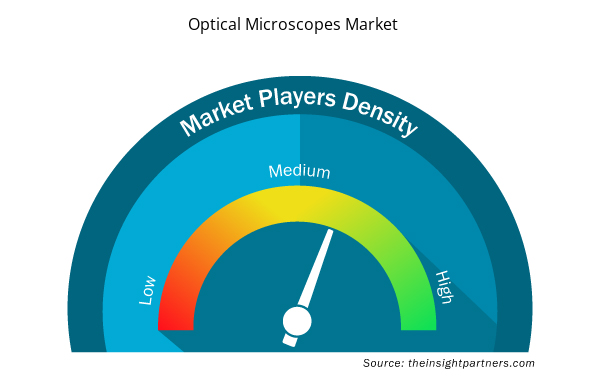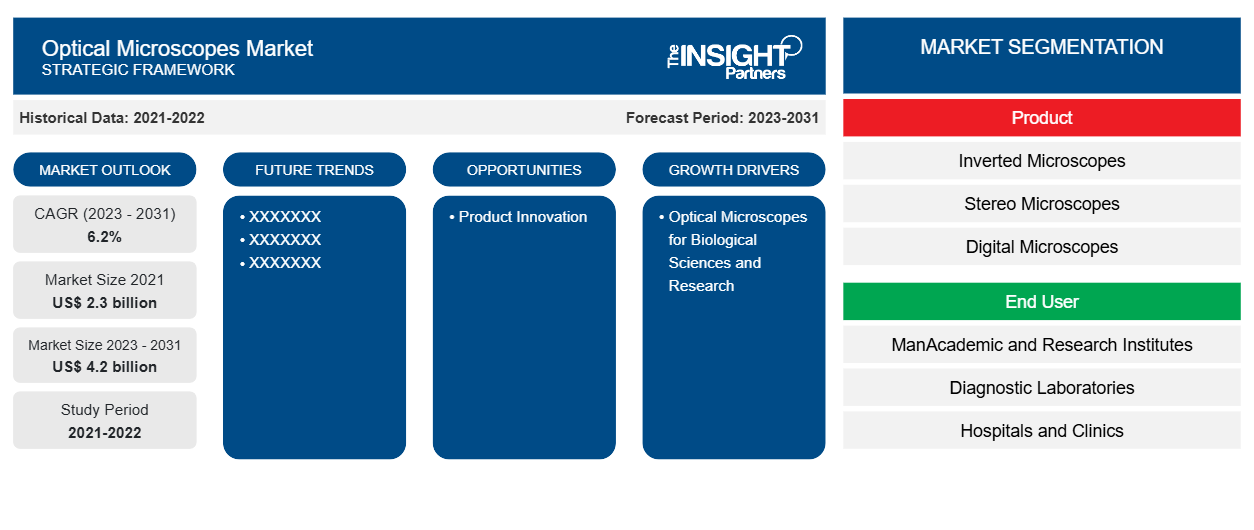光学顕微鏡市場は2021年に23億米ドルと評価され、2031年までに42億米ドルに達すると予想されています。市場は2023年から2031年にかけて6.2%のCAGRを記録すると予想されています。
市場における技術の進歩と戦略的提携は、光学顕微鏡市場の主要なトレンドであり続けると思われます。
光学顕微鏡市場分析
生物科学および研究用光学顕微鏡
生物科学の進歩は光学顕微鏡と関係しています。光学顕微鏡は、核、ミトコンドリア、葉緑体などの真核細胞を観察するために使用できます。さらに、光学顕微鏡は、細胞生物学、バイオテクノロジー、生命科学、ナノテクノロジー、臨床診断のための組織病理組織切片の検査の分野で、さまざまなイメージングアプリケーション用の可視電磁放射を備えています。さらに、メーカーは、生物学的サンプルの高倍率と優れた視認性を備えた革新的な光学顕微鏡を開発しています。光学顕微鏡の「細胞内解像度」を介して大きな胚と細胞組織をイメージングする McConnell の新しい光学顕微鏡は、注目すべき例です。したがって、患者の臨床ニーズを満たす生物科学と研究を目的とした、より優れたイメージングを備えた光学顕微鏡の進歩は、市場の成長に最も影響を与える要因の 1 つです。
光学顕微鏡市場の概要
テクノロジー、イノベーション、スマートなテクノロジーソリューションは、光学顕微鏡市場に大きな影響を及ぼし続けています。生物科学と研究のための光学顕微鏡と、光学顕微鏡の高倍率と高解像度は、光学顕微鏡市場の成長に最も影響を与える要因です。光学顕微鏡製品の進歩は、光学顕微鏡市場の成長の重要なトレンドです。製品のイノベーションは、光学顕微鏡市場の成長に有利な市場機会を提供します。
要件に合わせてレポートをカスタマイズする
このレポートの一部、国レベルの分析、Excelデータパックなど、あらゆるレポートを無料でカスタマイズできます。また、スタートアップや大学向けのお得なオファーや割引もご利用いただけます。
- このレポートの主要な市場動向を入手してください。この無料サンプルには、市場動向から見積もりや予測に至るまでのデータ分析が含まれます。
光学顕微鏡市場の推進要因と機会
市場を有利にする高倍率・高解像度の光学顕微鏡の導入
20年にわたり、科学者は光学顕微鏡を使用して物体を検出、追跡、および位置特定できることを発見してきました。しかし、今日では、国立標準技術研究所(NIST)の研究部門により、顕微鏡でナノメートルスケール(NM)の詳細を高精度で測定できるようになりました。たとえば、NISTは、画像エラーを綿密に検査して修正する新しいキャリブレーションプロセスを開発しました。また、この先駆的な研究により、受精卵のタンパク質を追跡したり、脳内の神経細胞間の電気的接続を形成する分子を視覚化したり、小型モーターのナノスケールの動きを研究したりすることが可能になり、2014年のノーベル化学賞を受賞しました。したがって、光学顕微鏡の高倍率と高解像度は、市場の成長に大きく貢献するでしょう。
製品イノベーション - チャンス
光学顕微鏡は、細胞生物学の進歩を推進する先進的な顕微鏡であり、生きた細胞や組織を検出するための空間的および時間的解像度を獲得しています。過去から、サンプルを蛍光ラベルで染色することは、生体分子を視覚化する高感度の方法を提供してきました。しかし、蛍光顕微鏡には、サンプルの操作と染色アーティファクト、蛍光体の光退色、関連する光毒性など、サンプルの染色に関連するいくつかの制限があります。そのため、研究者は、以前は蛍光顕微鏡では利用できなかった光学顕微鏡の定量機能を提供できるラベルフリー光学顕微鏡技術の開発に多くの努力を注いでいます。たとえば、研究室では、合成脂質膜や生きた細胞のナノ粒子材料を検出するためのアプリケーション全体で革新的な励起/検出スキームを備えた定量的なラベルフリー光学顕微鏡を開発しています。また、研究室では、前例のない感度で単一タンパク質脂質膜相互作用を監視するための新しい広視野干渉反射測定法を開発しています。したがって、革新的な製品イノベーションは、今後数年間、光学顕微鏡市場に有利な市場機会を提供するでしょう。
光学顕微鏡市場レポートのセグメンテーション分析
光学顕微鏡市場分析の導出に貢献した主要なセグメントは、候補とサービスです。
- 製品別に見ると、光学顕微鏡市場は倒立顕微鏡、実体顕微鏡、デジタル顕微鏡、付属品に分かれています。倒立顕微鏡セグメントは2023年に市場シェアを拡大する可能性があります。
- エンドユーザー別に見ると、市場は学術・研究機関、診断研究所、病院・診療所、製薬・バイオテクノロジー企業に分類されます。学術・研究機関セグメントは、2023年に市場で最大のシェアを占める可能性があります。
光学顕微鏡の地域別市場シェア分析
光学顕微鏡市場レポートの地理的範囲は、主に北米、アジア太平洋、ヨーロッパ、中東およびアフリカ、南米/中南米の 5 つの地域に分かれています。
光学顕微鏡市場は北米が支配的でした。北米では、米国が光学顕微鏡の大きなシェアを占めています。米国にトップクラスの医療機器会社が存在し、技術的に高度な製品が市場の成長に最も影響を与えています。今後数年間、アジア太平洋地域は最高の CAGR で成長すると予想されています。
光学顕微鏡市場の地域別分析
予測期間を通じて光学顕微鏡市場に影響を与える地域的な傾向と要因は、Insight Partners のアナリストによって徹底的に説明されています。このセクションでは、北米、ヨーロッパ、アジア太平洋、中東およびアフリカ、南米および中米にわたる光学顕微鏡市場のセグメントと地理についても説明します。

- 光学顕微鏡市場の地域別データを入手
光学顕微鏡市場レポートの範囲
| レポート属性 | 詳細 |
|---|---|
| 2021年の市場規模 | 23億米ドル |
| 2031年までの市場規模 | 42億米ドル |
| 世界のCAGR(2023年~2031年) | 6.2% |
| 履歴データ | 2021-2022 |
| 予測期間 | 2023-2031 |
| 対象セグメント | 製品別
|
| 対象地域と国 | 北米
|
| 市場リーダーと主要企業プロフィール |
|
光学顕微鏡市場のプレーヤー密度:ビジネスダイナミクスへの影響を理解する
光学顕微鏡市場は、消費者の嗜好の変化、技術の進歩、製品の利点に対する認識の高まりなどの要因により、エンドユーザーの需要が高まり、急速に成長しています。需要が高まるにつれて、企業は提供を拡大し、消費者のニーズを満たすために革新し、新たなトレンドを活用し、市場の成長をさらに促進しています。
市場プレーヤー密度とは、特定の市場または業界内で活動している企業または会社の分布を指します。これは、特定の市場スペースに、その市場規模または総市場価値に対してどれだけの競合相手 (市場プレーヤー) が存在するかを示します。
光学顕微鏡市場で事業を展開している主要企業は次のとおりです。
- 株式会社ニコン
- カールツァイスAG
- アジレントテクノロジー株式会社
- ブルカー
- オリンパス株式会社
- ライカマイクロシステムズ
免責事項:上記の企業は、特定の順序でランク付けされていません。

- 光学顕微鏡市場のトップキープレーヤーの概要を入手
光学顕微鏡市場のニュースと最近の動向
光学顕微鏡市場は、主要な企業出版物、協会データ、データベースを含む一次および二次調査後の定性的および定量的データを収集することによって評価されます。以下は、光学顕微鏡市場の動向と戦略のリストです。
- ニコン株式会社(以下、ニコン)は、2023年4月に、国内初となる医療用顕微鏡として、デジタルイメージング顕微鏡「ECLIPSE Ui」を開発、発売すると発表しました。ECLIPSE Uiは、接眼レンズのない独自のデザインで、病理医の観察姿勢の改善や、ディスプレイでの観察画像の共有を可能にしました。病理医の身体的負担軽減や病理観察のワークフローの短縮に貢献します。
光学顕微鏡市場レポートの対象範囲と成果物
「光学顕微鏡市場の規模と予測(2021〜2031年)」レポートでは、以下の分野をカバーする市場の詳細な分析を提供しています。
- 対象範囲に含まれるすべての主要市場セグメントの世界、地域、国レベルでの市場規模と予測
- 市場の動向(推進要因、制約、主要な機会など)
- 今後の主な動向
- 詳細なPEST/ポーターの5つの力とSWOT分析
- 主要な市場動向、主要プレーヤー、規制、最近の市場動向を網羅した世界および地域の市場分析
- 市場集中、ヒートマップ分析、主要プレーヤー、最近の動向を網羅した業界の状況と競争分析
- 詳細な企業プロフィール
- 過去2年間の分析、基準年、CAGRによる予測(7年間)
- PEST分析とSWOT分析
- 市場規模価値/数量 - 世界、地域、国
- 業界と競争環境
- Excel データセット


- Webbing Market
- Third Party Logistics Market
- Online Recruitment Market
- Quantitative Structure-Activity Relationship (QSAR) Market
- Wire Harness Market
- Aerosol Paints Market
- Blood Collection Devices Market
- Semiconductor Metrology and Inspection Market
- Foot Orthotic Insoles Market
- Pharmacovigilance and Drug Safety Software Market

Report Coverage
Revenue forecast, Company Analysis, Industry landscape, Growth factors, and Trends

Segment Covered
This text is related
to segments covered.

Regional Scope
North America, Europe, Asia Pacific, Middle East & Africa, South & Central America

Country Scope
This text is related
to country scope.
Trends and growth analysis reports related to Life Sciences : READ MORE..
The Insight Partners performs research in 4 major stages: Data Collection & Secondary Research, Primary Research, Data Analysis and Data Triangulation & Final Review.
- Data Collection and Secondary Research:
As a market research and consulting firm operating from a decade, we have published and advised several client across the globe. First step for any study will start with an assessment of currently available data and insights from existing reports. Further, historical and current market information is collected from Investor Presentations, Annual Reports, SEC Filings, etc., and other information related to company’s performance and market positioning are gathered from Paid Databases (Factiva, Hoovers, and Reuters) and various other publications available in public domain.
Several associations trade associates, technical forums, institutes, societies and organization are accessed to gain technical as well as market related insights through their publications such as research papers, blogs and press releases related to the studies are referred to get cues about the market. Further, white papers, journals, magazines, and other news articles published in last 3 years are scrutinized and analyzed to understand the current market trends.
- Primary Research:
The primarily interview analysis comprise of data obtained from industry participants interview and answers to survey questions gathered by in-house primary team.
For primary research, interviews are conducted with industry experts/CEOs/Marketing Managers/VPs/Subject Matter Experts from both demand and supply side to get a 360-degree view of the market. The primary team conducts several interviews based on the complexity of the markets to understand the various market trends and dynamics which makes research more credible and precise.
A typical research interview fulfils the following functions:
- Provides first-hand information on the market size, market trends, growth trends, competitive landscape, and outlook
- Validates and strengthens in-house secondary research findings
- Develops the analysis team’s expertise and market understanding
Primary research involves email interactions and telephone interviews for each market, category, segment, and sub-segment across geographies. The participants who typically take part in such a process include, but are not limited to:
- Industry participants: VPs, business development managers, market intelligence managers and national sales managers
- Outside experts: Valuation experts, research analysts and key opinion leaders specializing in the electronics and semiconductor industry.
Below is the breakup of our primary respondents by company, designation, and region:

Once we receive the confirmation from primary research sources or primary respondents, we finalize the base year market estimation and forecast the data as per the macroeconomic and microeconomic factors assessed during data collection.
- Data Analysis:
Once data is validated through both secondary as well as primary respondents, we finalize the market estimations by hypothesis formulation and factor analysis at regional and country level.
- Macro-Economic Factor Analysis:
We analyse macroeconomic indicators such the gross domestic product (GDP), increase in the demand for goods and services across industries, technological advancement, regional economic growth, governmental policies, the influence of COVID-19, PEST analysis, and other aspects. This analysis aids in setting benchmarks for various nations/regions and approximating market splits. Additionally, the general trend of the aforementioned components aid in determining the market's development possibilities.
- Country Level Data:
Various factors that are especially aligned to the country are taken into account to determine the market size for a certain area and country, including the presence of vendors, such as headquarters and offices, the country's GDP, demand patterns, and industry growth. To comprehend the market dynamics for the nation, a number of growth variables, inhibitors, application areas, and current market trends are researched. The aforementioned elements aid in determining the country's overall market's growth potential.
- Company Profile:
The “Table of Contents” is formulated by listing and analyzing more than 25 - 30 companies operating in the market ecosystem across geographies. However, we profile only 10 companies as a standard practice in our syndicate reports. These 10 companies comprise leading, emerging, and regional players. Nonetheless, our analysis is not restricted to the 10 listed companies, we also analyze other companies present in the market to develop a holistic view and understand the prevailing trends. The “Company Profiles” section in the report covers key facts, business description, products & services, financial information, SWOT analysis, and key developments. The financial information presented is extracted from the annual reports and official documents of the publicly listed companies. Upon collecting the information for the sections of respective companies, we verify them via various primary sources and then compile the data in respective company profiles. The company level information helps us in deriving the base number as well as in forecasting the market size.
- Developing Base Number:
Aggregation of sales statistics (2020-2022) and macro-economic factor, and other secondary and primary research insights are utilized to arrive at base number and related market shares for 2022. The data gaps are identified in this step and relevant market data is analyzed, collected from paid primary interviews or databases. On finalizing the base year market size, forecasts are developed on the basis of macro-economic, industry and market growth factors and company level analysis.
- Data Triangulation and Final Review:
The market findings and base year market size calculations are validated from supply as well as demand side. Demand side validations are based on macro-economic factor analysis and benchmarks for respective regions and countries. In case of supply side validations, revenues of major companies are estimated (in case not available) based on industry benchmark, approximate number of employees, product portfolio, and primary interviews revenues are gathered. Further revenue from target product/service segment is assessed to avoid overshooting of market statistics. In case of heavy deviations between supply and demand side values, all thes steps are repeated to achieve synchronization.
We follow an iterative model, wherein we share our research findings with Subject Matter Experts (SME’s) and Key Opinion Leaders (KOLs) until consensus view of the market is not formulated – this model negates any drastic deviation in the opinions of experts. Only validated and universally acceptable research findings are quoted in our reports.
We have important check points that we use to validate our research findings – which we call – data triangulation, where we validate the information, we generate from secondary sources with primary interviews and then we re-validate with our internal data bases and Subject matter experts. This comprehensive model enables us to deliver high quality, reliable data in shortest possible time.


 このレポートの無料サンプルを入手する
このレポートの無料サンプルを入手する